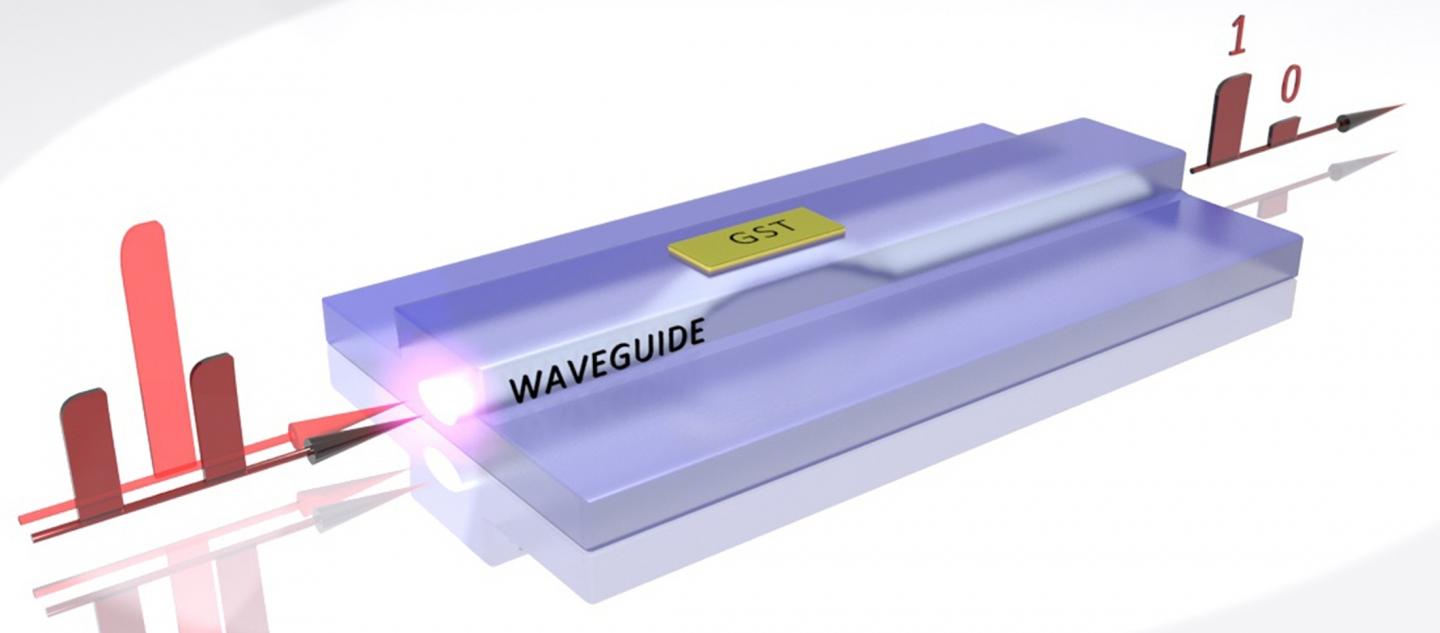First all-optical chip memory
September 23, 2015

Illustration of all-optical data memory: ultra-short light pulses (left) make a bit in the Ge2Sb2Te5 (GST) material change from crystalline to amorphous (or the reverse), and weak light pulses (right) read out the data (credit: C. Rios/Oxford University)
The first all-optical chip memory has been developed by an international team of scientists. It is capable of writing data to memory at a speed of up to a gigahertz or more and may allow computers to work more rapidly and more efficiently.
The memory is non-volatile (similar to flash memory), and the new memory can store data even when the power is removed, and may persist for decades, the researchers believe.
The scientists, from Oxford, Exeter, Karlsruhe and Münster universities, used a “phase-change material,” Ge2Sb2Te5 (GST). Phase-change materials radically change their optical properties depending on their phase state (arrangement of the atoms) — crystalline (regular) or amorphous (irregular) — initiated by ultrashort light pulses. For reading out the data, weak light pulses are used.
Light is ideally suited for ultra-fast high-bandwidth data transfer (via optical-fiber cables), but until now, it has not been possible to store large quantities of optical data directly on integrated chips. The memory is also compatible with latest processors, the researchers note.
Permanent all-optical on-chip memories promise to considerably increase the speed of computers and reduce their energy consumption. Together with all-optical connections, on-chip memories might also reduce latencies (transmission delays, which can make long-distance two-way communication difficult, for example). In addition, energy-intensive conversion of optical signals into electronic signals and vice versa would no longer be required, reducing bulk and cost.
The research is published in Nature Photonics.
Abstract of Integrated all-photonic non-volatile multi-level memory
Implementing on-chip non-volatile photonic memories has been a long-term, yet elusive goal. Photonic data storage would dramatically improve performance in existing computing architectures by reducing the latencies associated with electrical memories and potentially eliminating optoelectronic conversions. Furthermore, multi-level photonic memories with random access would allow for leveraging even greater computational capability. However, photonic memories have thus far been volatile. Here, we demonstrate a robust, non-volatile, all-photonic memory based on phase-change materials. By using optical near-field effects, we realize bit storage of up to eight levels in a single device that readily switches between intermediate states. Our on-chip memory cells feature single-shot readout and switching energies as low as 13.4 pJ at speeds approaching 1 GHz. We show that individual memory elements can be addressed using a wavelength multiplexing scheme. Our multi-level, multi-bit devices provide a pathway towards eliminating the von Neumann bottleneck and portend a new paradigm in all-photonic memory and non-conventional computing.